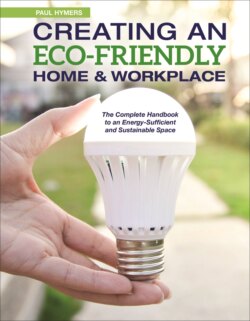Читать книгу Creating an Eco-Friendly Home & Workplace - Paul Hymers - Страница 18
На сайте Литреса книга снята с продажи.
Converting your lighting
ОглавлениеIn terms of conserving power, converting the lighting of your home to more eco-friendly status is the easiest way to achieve results.
Lighting tends to be forgotten until it is too late to reap the full benefits of choice and design, but with any eco-conversion project, it needs pushing to the front of your mind – well ahead of the decorating. Don’t let your efforts stop at fitting a few low-energy light bulbs. You might also look at switching: an internal passive infrared (PIR) switch (see Glossary) or a programmable dimmer switch may be far more efficient than a manual switch that always produces full power and tends to be left on after the room has been vacated. Spaces that we visit temporarily are prone to this. Bathrooms, hallways, stairs and landings that we pass through are all ideal areas for automatic PIR detector switching.
Fitting a PIR that can be adjusted for the time period it stays on after the area has been vacated is essential. I have one that switches on a low-level brick light in my en-suite bathroom. It produces more than enough light from a 10 watt lamp to use the room at night without disturbing anyone and switches off a minute after the room has been left, just enough time to use the reflected light to find my way back to bed.
What matters most about lighting is getting it in the right place and achieving the right effect. Light can be stark and even, bright with contrasting shadow, soft and relaxing, and a variety of hues if not colours. Deciding on what you want for a particular room will mean thinking about how you plan to use that room. In kitchens, adjustable and worktop lights should be employed as task lighting. Bathrooms, bedrooms and dining-rooms benefit from softer light to create a relaxed atmosphere, and lounges may need a variety of lighting options for reading, watching TV and so on. New homes often demonstrate an astounding lack of imagination when it comes to lighting, developers hanging a pendant fitting somewhere near the centre of each ceiling and leaving it at that. That is ambient or general lighting. It is the canvas on which you can create something better, something that is not only more energy-efficient, but also more imaginative and atmospheric. Eco-conversion work can give you the opportunity to install light fittings where you’ve always wanted them, to produce something unique, illuminating your home more effectively and efficiently to save energy in the process.
Energy-efficient lighting relies on three key elements:
• The right position
• The right light source
• The right light fitting
